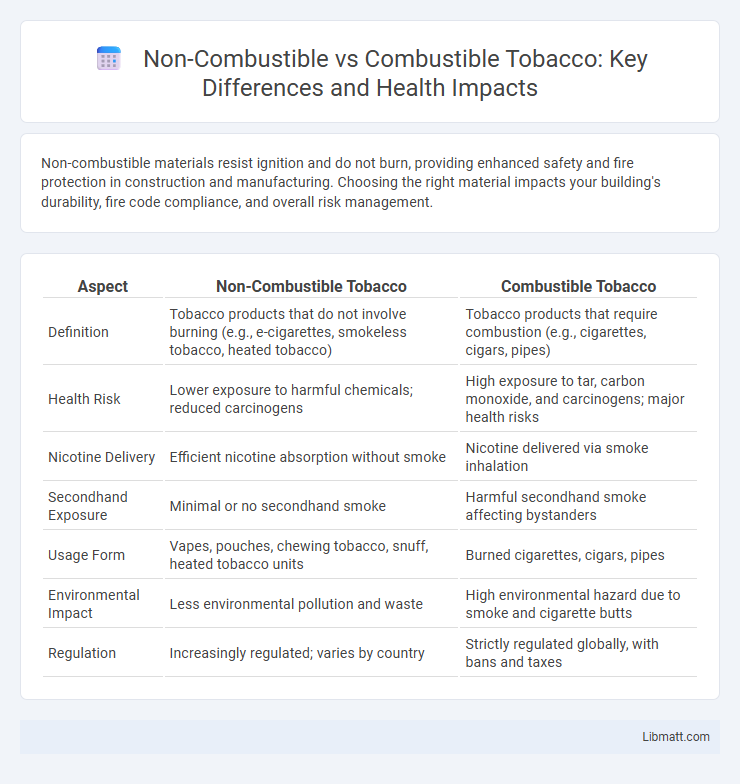Non-combustible materials resist ignition and do not burn, providing enhanced safety and fire protection in construction and manufacturing. Choosing the right material impacts your building's durability, fire code compliance, and overall risk management.
Table of Comparison
| Aspect | Non-Combustible Tobacco | Combustible Tobacco |
|---|---|---|
| Definition | Tobacco products that do not involve burning (e.g., e-cigarettes, smokeless tobacco, heated tobacco) | Tobacco products that require combustion (e.g., cigarettes, cigars, pipes) |
| Health Risk | Lower exposure to harmful chemicals; reduced carcinogens | High exposure to tar, carbon monoxide, and carcinogens; major health risks |
| Nicotine Delivery | Efficient nicotine absorption without smoke | Nicotine delivered via smoke inhalation |
| Secondhand Exposure | Minimal or no secondhand smoke | Harmful secondhand smoke affecting bystanders |
| Usage Form | Vapes, pouches, chewing tobacco, snuff, heated tobacco units | Burned cigarettes, cigars, pipes |
| Environmental Impact | Less environmental pollution and waste | High environmental hazard due to smoke and cigarette butts |
| Regulation | Increasingly regulated; varies by country | Strictly regulated globally, with bans and taxes |
Introduction to Combustible and Non-Combustible Materials
Combustible materials ignite and burn easily, posing higher fire risks in building construction and safety. Non-combustible materials, such as concrete, steel, and certain types of glass, resist ignition and do not contribute to fire spread, making them ideal for fireproofing applications. Understanding the differences between these materials ensures Your choices enhance safety and comply with fire codes in various environments.
Key Differences Between Combustible and Non-Combustible Materials
Non-combustible materials, such as concrete, steel, and glass, do not ignite, burn, or release flammable vapors when exposed to fire, making them essential for fire-resistant construction. Combustible materials like wood, paper, and certain plastics readily catch fire, contributing to rapid flame spread and increased fire hazards. Building codes prioritize non-combustible materials for fire safety, particularly in high-risk environments, due to their superior performance in limiting fire growth and smoke production.
Fire Safety Standards and Regulations
Non-combustible materials such as steel and concrete meet stringent fire safety standards by resisting ignition and limiting flame spread, making them a preferred choice in building codes worldwide. Combustible materials like wood require careful treatment and adherence to regulations including NFPA (National Fire Protection Association) guidelines to reduce fire hazards. Fire safety regulations enforce strict testing methods, such as ASTM E136 for non-combustibility and ASTM E119 for fire resistance, ensuring materials comply with safety thresholds in construction projects.
Applications of Combustible Materials
Combustible materials are widely used in construction, packaging, and textiles due to their flexibility and cost-effectiveness. These materials, including wood, paper, and certain plastics, are favored for applications requiring easy shaping and aesthetic versatility. Understanding their fire risks is crucial for ensuring safety in your design or manufacturing processes.
Uses of Non-Combustible Materials in Construction
Non-combustible materials such as steel, concrete, and glass play a critical role in enhancing fire resistance in building construction. These materials are predominantly used in structural components, fire barriers, and exterior cladding to prevent the spread of flames and protect occupants. Their inherent fire-resistive properties help meet stringent building codes and improve overall safety in commercial, residential, and industrial projects.
Performance and Durability Comparison
Non-combustible materials, such as concrete and steel, offer superior fire resistance, maintaining structural integrity under extreme heat without releasing toxic fumes, enhancing safety and durability. Combustible materials like wood are more susceptible to fire damage, compromising performance over time due to burning and warping, though they provide certain aesthetic and insulation benefits. Your choice between these materials should consider long-term durability needs and compliance with fire safety regulations to optimize overall building performance.
Environmental Impact: Combustible vs. Non-Combustible
Non-combustible materials produce fewer harmful emissions and reduce air pollution compared to combustible materials, which release significant amounts of carbon dioxide, particulate matter, and toxic gases during burning. Non-combustible materials contribute to improved indoor and outdoor air quality, lowering health risks associated with smoke inhalation and chemical exposure. The reduced environmental footprint of non-combustible materials supports sustainable building practices and helps mitigate climate change effects.
Cost Analysis: Which Material is More Economical?
Non-combustible materials such as concrete, brick, and steel typically have higher upfront costs compared to combustible materials like wood and vinyl due to their durability and fire resistance. However, long-term cost analysis reveals that non-combustible materials reduce expenses related to fire damage repairs, insurance premiums, and maintenance. When factoring in lifecycle costs and safety benefits, non-combustible materials often prove more economical despite the initial investment.
Selecting the Right Material for Your Project
Non-combustible materials such as concrete, steel, and glass offer superior fire resistance, making them ideal for projects requiring high safety standards. Combustible options like wood and certain plastics provide cost-effective flexibility but require careful consideration of fire codes and insulation needs. Selecting the right material for your project depends on balancing fire safety, budget constraints, and design goals to ensure compliance and durability.
Future Trends in Material Development and Fire Safety
Advancements in fire-resistant materials emphasize the increased development of non-combustible composites that offer enhanced thermal insulation and structural integrity during fires. Innovations in nano-coatings and intumescent technologies aim to improve the fire retardancy of combustible materials without compromising their mechanical properties. Regulatory frameworks are gradually favoring non-combustible materials to reduce fire hazards and promote sustainable building practices worldwide.
Non-combustible vs combustible Infographic

 libmatt.com
libmatt.com